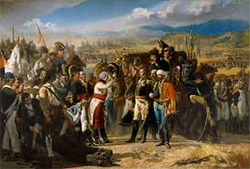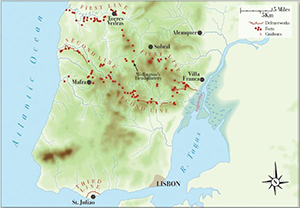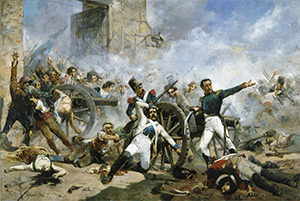The Peninsular War
Part 2: Fighting on Multiple Fronts

Joseph Bonaparte entered Madrid on July 20, after the French forces had restored stability in the capital. He was crowned King of Spain on July 25. Meanwhile, the emboldened Spanish were gaining in strength and confidence. Of particular significance was the fate of French Gen. Pierre Dupont, whose 20,000 men were tasked with putting down any resistance in Andalusia. Through a series of misadventures, they found themselves trapped between two Spanish forces, together numbering more men and weapons than Dupont had. At the Battle of Bailén, the Frenchman tried to fight his way out and was repulsed. He agreed to surrender his entire army and was made a prisoner of war. As well, an uprising in Madrid gained control of the city and forced Joseph Bonaparte to flee. At the same time, other French troops had carried on into Portugal, which, naturally didn't appreciate the invasion. Troops from the U.K. came to Portugal's aid, beginning in 1808, and the Peninsular War began. Gen. Arthur Wellesley and 15,000 U.K. troops landed in Portugal in August 1808 and began forcing French troops back into Spain. These actions culminated in a U.K. victory at Vimeiro, on August 21, forcing Junot to leave Portugal altogether. 
In response, Napoleon himself led an invasion of Spain by 200,000 experienced soldiers, overwhelming the Spanish troops, retaking Madrid on December 1, and restoring his brother to the throne. French troops made gains elsewhere in Spain, restoring some sense of the order that had accompanied the initial invasion just as an English-Portuguese force under Sir John Moore was advancing over the Iberian border and into Spain. The U.K. troops didn't get very far or provide much in the way of support; by the end of the year, they had retreated back into Portugal and most of them sailed back to the U.K. (One who didn't was Moore, the commander, killed in the fighting that preceded the escape.) Seeing this, and hearing of trouble with Austria, Napoleon returned to France, in January 1809. Left in charge of the French army in Spain was Marshal General Jean de Dieu Soult. Wellesley returned in April 1809, after having survived a military scandal, and assumed command of the English-Portuguese force. He set about reorganizing the troops and then set about defeating the French. The allied force clashed with Soult at Porto on May 12, and the result was a French retreat. Wellesley's troops marched into Spain, joined forces with a Spanish force, and marched on into the Spanish heartland. 
Joseph Bonaparte led troops into battle against this new invasion force in July, at Talavera. The U.K. victory there earned Wellesley elevation to the Peerage, and he was named Viscount Wellington of Talavera and of Wellington, Somerset. As the year wore down, the allied force concentrated on building the Lines of Torres Vedras, in order to protect Lisbon from what was sure to be a renewed French offensive. The fighting across Spain continued to be sporadic yet fierce. Even though France was involved in yet another war against a Coalition, the occupation troops fought on, determined to not only hold on to Spain but also to conquer Portugal. A large force under Andre Masséna pushed the allied troops back and back, forcing them to retreat between the Lines in September 1810. Despite repeated attempts, the French proved unable to breach those defenses. The arrival of reinforcements from the U.K. in March 1811 provided Wellington with the impetus to strike back, and the French force left Portugal again. Next page > Throwing Off the Invaders > Page 1, 2, 3 |
|
Social Studies for Kids
copyright 2002–2026
David White



 A large number of people in Madrid had already rebelled against French authority, and Murat and many of this troops reacted with force in quelling the disturbance. In a foreshadowing for the bitterness and cruelty that was to come, French troops gunned down civilians as a reprisal for the uprising. The people of Spain didn't at all want a foreigner ruling their country, and they put up quite a fight during a number of years, waging guerrilla war and requiring France to keep many more troops in the country than it otherwise would have. Local militias known as Miquelets won several battles against French troops. French supplies of men, money, and weapons were not limitless, and the occupation army grew to such an extent that it had a bearing on actions that the French Army could take elsewhere in Europe.
A large number of people in Madrid had already rebelled against French authority, and Murat and many of this troops reacted with force in quelling the disturbance. In a foreshadowing for the bitterness and cruelty that was to come, French troops gunned down civilians as a reprisal for the uprising. The people of Spain didn't at all want a foreigner ruling their country, and they put up quite a fight during a number of years, waging guerrilla war and requiring France to keep many more troops in the country than it otherwise would have. Local militias known as Miquelets won several battles against French troops. French supplies of men, money, and weapons were not limitless, and the occupation army grew to such an extent that it had a bearing on actions that the French Army could take elsewhere in Europe.
